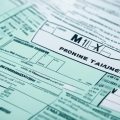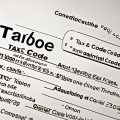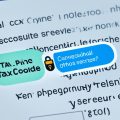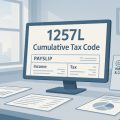A W1 tax code is an emergency tax code used in the UK. It is assigned by HMRC when there isn’t enough information to issue the correct tax code. The W1 tax code is temporary and is typically used for individuals who are paid on a weekly basis. This code is non-cumulative, meaning it only considers the earnings for that specific pay period and does not take into account any tax already paid in the tax year.
Understanding your W1 tax code is important as it affects how much tax you pay and your overall tax allowance. It is crucial to check your tax code regularly as it can change throughout the year. By keeping track of your tax code, you can ensure that you are paying the correct amount of tax based on your earnings and personal circumstances.
How Does a W1 Tax Code Work?
A W1 tax code works by calculating your tax based only on what you earn in the current pay period, rather than taking into account your annual income. This means that the tax you pay each week is based solely on your weekly earnings. The W1 tax code is part of the PAYE (Pay As You Earn) system, which ensures that taxes are deducted directly from your salary.
It is important to check your tax code regularly to ensure that it is correct and up to date. Tax codes can change throughout the year due to various factors such as changes in your income, employment status, or changes implemented by HMRC. These changes can impact how much tax you should be paying.
HMRC assigns tax codes based on individual circumstances. The tax code is usually made up of a combination of letters and numbers. The letters indicate information about your personal situation, while the numbers represent the amount of tax-free allowance you have for that tax year.
To check your tax code, you can log into your personal tax account on the HMRC website. Alternatively, you can contact HMRC directly for assistance.
Understanding Your Tax Code Letter
The letter in your tax code, also known as a tax code letter, provides important information about your tax situation. Here are some common tax code letters and their meanings:
- L – You are entitled to the standard tax-free allowance.
- K – You have deductions that reduce your tax-free allowance (e.g., state benefits or company benefits).
- T – The HMRC needs more information before issuing a final tax code.
- NT – You pay no tax on your income.
These letters are just a few examples, and there are many more variations depending on your personal circumstances. It’s important to understand the meaning of the letter(s) in your tax code to ensure that you are paying the correct amount of tax.
Checking your tax code regularly and understanding how it works is essential to ensure that you are paying the right amount of tax. It’s always a good idea to keep track of any tax code changes and seek guidance from HMRC if you have any doubts or questions about your tax code.
Understanding the Letters in a W1 Tax Code
The letters in a W1 tax code provide valuable information about your specific situation and how it impacts your Personal Allowance. Here are some common letters you may come across in a W1 tax code:
Letter L
If you have the letter L in your W1 tax code, it means that you are entitled to the standard tax-free Personal Allowance. The Personal Allowance is the amount of income you can earn before you start paying tax. For example, in the current tax year, the standard Personal Allowance is £12,570.
Letter M
A W1 tax code with the letter M indicates that you have received the Marriage Allowance, where a portion of your partner’s Personal Allowance has been transferred to you. This usually happens when one partner earns less than the Personal Allowance and the other partner is a basic rate taxpayer. It allows the lower-earning partner to benefit from the unused tax-free allowance.
Letter N
If you have the letter N in your W1 tax code, it means that you have transferred some of your Personal Allowance to your partner through the Marriage Allowance. This can happen if your income is below the Personal Allowance threshold and your partner is a basic rate taxpayer.
Letter T
The letter T in a W1 tax code signifies that there are other calculations being applied to your tax code. This could include adjustments for other income sources, deductions, or benefits.
Example
Let’s say you have a W1 tax code of 1250L. In this case, the letter L indicates that you are entitled to the standard tax-free Personal Allowance of £12,570. Your employer will deduct tax from your earnings based on this information.
Understanding the letters in your W1 tax code is vital as it helps you comprehend how it affects your tax liability and any allowances you are entitled to. It is important to review your tax code regularly to ensure its accuracy and to notify HMRC if any changes to your circumstances occur. Monitoring your tax code can help avoid any potential overpayments or underpayments and ensure that you are paying the correct amount of tax.

How to Update Your W1 Tax Code?
Updating your W1 tax code is crucial to ensure that you are paying the correct amount of tax based on your current circumstances. There are several ways to update your tax code:
- Online: The easiest and most convenient way to update your tax code is through the HMRC website. Log into your personal tax account and navigate to the tax code section. Here, you can make changes to your tax code by providing updated information such as your income, deductions, or employment status. Make sure to double-check all the details before submitting to avoid any discrepancies.
- By Phone: If you prefer speaking to someone directly, you can contact HMRC’s tax helpline. The customer service representative will guide you through the process of updating your tax code over the phone. Remember to have all the necessary information ready, such as your National Insurance number and employment details, to expedite the process.
- By Letter: In some cases, you may need to update your tax code by sending a letter to HMRC. This may be necessary if you have complex circumstances that cannot be easily updated online or over the phone. Ensure that you provide all relevant details and supporting documentation with your letter for a smooth process.
- Through Your Employer: If you’ve experienced changes in your employment, such as starting a new job or switching employers, it’s important to inform your employer about any updates to your tax code. They will then notify HMRC and make the necessary adjustments to ensure accurate tax deductions from your paycheck.
Updating your W1 tax code promptly is vital to prevent overpaying or underpaying taxes. Failure to update your tax code may result in penalties or discrepancies in your tax calculations. It is advisable to review your tax code regularly and update it whenever there are changes to your personal or employment circumstances.
In the next section, we will discuss how a W1 tax code impacts your pay and what you need to know about potential tax code changes.

How Does a W1 Tax Code Impact Your Pay?
A W1 tax code has a direct impact on your pay as it determines the amount of tax that will be deducted from your earnings. Unlike a regular tax code, a W1 tax code calculates tax based only on what you earn in the current pay period, rather than considering your total annual income. This means that your weekly tax deductions may be higher compared to someone with a regular tax code.
However, there is a potential advantage to having a W1 tax code. Since tax is calculated on a weekly basis and does not take into account your total annual income, there is a possibility of overpaying tax throughout the year. If you have overpaid tax, you may be entitled to a tax code refund.
Understanding your W1 tax code is crucial in order to accurately assess the impact it has on your pay. By regularly reviewing your tax code and making any necessary adjustments, you can ensure that you are paying the correct amount of tax. This will help you avoid overpaying throughout the year and maximize your take-home pay.
Reviewing Your W1 Tax Code
To review your W1 tax code, you can log into your personal tax account on the HMRC website or get in touch with HMRC directly. It’s important to stay up to date with your tax code to ensure that it accurately reflects your current circumstances. This will help prevent any potential discrepancies and ensure that your pay is not affected negatively due to incorrect tax calculations.

Maximizing Your Personal Tax Code
In addition to understanding your W1 tax code, it’s also worth exploring opportunities to maximize your personal tax code. The personal tax code is an allowance that determines the amount of income you can earn before you start paying tax. By utilizing all available tax allowances and considering tax-saving strategies, you can potentially reduce your overall tax liability and increase your take-home pay.
It’s important to note that tax codes can change throughout the year due to various factors, such as changes in your employment status or income. Therefore, it is recommended to review your tax code regularly and seek professional advice if needed to ensure you are optimizing your tax situation.
Why Your W1 Tax Code Might Change?
Your W1 tax code can undergo changes due to various factors. These changes are crucial to ensure that your tax contributions are accurate and aligned with your specific circumstances. Understanding why your W1 tax code might change can help you stay informed and take appropriate action when necessary.
Common Reasons for Tax Code Changes
- Employment changes – When you switch jobs, receive a promotion, or experience changes in your work arrangement, such as moving from part-time to full-time employment, your tax code may change to reflect your new income.
- Pension income – If you begin receiving pension income, whether it’s from the state or a private pension scheme, your tax code may be adjusted to account for this additional source of income.
- Benefits or allowances – Changes in the benefits or allowances you receive, such as the Personal Allowance, can trigger a tax code adjustment to ensure you are correctly taxed based on the changes to your entitlements.
- Marital status – Getting married or entering into a civil partnership can lead to changes in your tax code, especially if your spouse or civil partner is earning an income.
- Errors or updates – Sometimes, errors can occur in the initial tax code assignment. If incorrect information was provided or there are updates to your income or circumstances, HMRC may issue a revised tax code.
It’s important to note that a change in your W1 tax code does not necessarily indicate an issue or error. Instead, it is a normal part of the tax system that allows for adjustments to accurately reflect your income and entitlements. Staying aware of common reasons for tax code changes can help you anticipate and navigate any adjustments that may occur.
To ensure you have the most up-to-date information regarding your tax code, it is recommended to regularly review your tax records, update HMRC with any changes in your circumstances, and seek guidance from HMRC or a tax professional if you have any questions or concerns.

| Reasons for Tax Code Changes | Implications |
|---|---|
| Employment changes | Reflects updated income and employment status. |
| Pension income | Accounts for additional income from pensions. |
| Benefits or allowances | Adjusts tax based on changes to entitlements. |
| Marital status | Considers combined income in cases of marriage or civil partnership. |
| Errors or updates | Corrects mistakes or reflects updated information. |
Conclusion
Understanding your W1 tax code is crucial to ensure that you are accurately paying the correct amount of tax based on your earnings and personal circumstances. The W1 tax code, although temporary, plays a significant role in determining your tax liabilities. It is important to keep in mind that this code should be updated as soon as the HMRC has enough information to issue the correct tax code, ensuring that you are not overpaying or underpaying your taxes.
By regularly reviewing your tax code and updating it when necessary, you can proactively manage your tax obligations. It is recommended to check your tax code periodically and seek assistance from HMRC if needed. This will help you stay on the right track with your tax payments and prevent any potential issues or discrepancies that may arise.
Remember, the HMRC is there to support you and provide guidance regarding your tax code. Utilize their resources to ensure that your W1 tax code aligns with your unique financial situation, allowing you to maintain compliance while maximizing your tax benefits.




















No Comments
Leave a comment Cancel